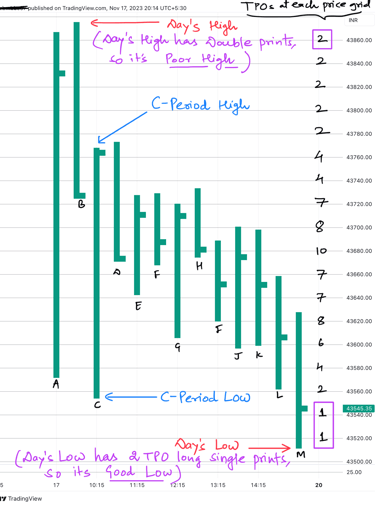Extremes
The underlying force for High & Low of the market auctions is the competition for the opportunity or lack of it.
11/19/20232 min read


Extremes i.e., High/Low can be: 1. Weak &/or 2. Poor (Non-excess) or 3. Good (Excess).
Good/Excess High or Low- When days High or Low is formed by single prints of significant length & also it must not occur during closing period (i.e., M Period); & the significant length is a matter of experience. Such an extreme has more conviction, hence profit expectations are liberal on such days. As said earlier, a good High/Low also means that the odds of taking it out in same or next trading session are lower.
Poor/Non-excess High or Low- The High/Low which is not a good extreme, automatically labelled as Poor extreme, & it may have double prints. Such an extreme is the result of mechanical traders, & has less conviction, hence market expectations are guarded on such days.
Weak High or Low- When days High or Low is exactly at or very close to any old reference levels (Support or Resistance levels). Interestingly, weak High or Low can be either Poor or Good extreme; thus, both Poor & Weak- High or Low has very low conviction.
Another way to look at ‘Poor’ extremes is in terms of inventory conditions of weaker money- i.e., is it ‘too long’ or ‘too short’?
Poor High means inventory might be ‘too long’ due to reckless buying by weaker money; and there is possibility of forced selling by EOD. Similarly, Poor Low means ‘too short’ inventory due to reckless selling or shorting by weaker money; and there is potential for forced buying back by the EOD. This forced market activity occurs so as to adjust weaker money’s inventory; hence called as ‘Inventory adjustment’. Let’s equate this with discount price sales by nearby stores. But, keep it in mind that- not necessarily inventory adjustments occur each time inventory gets recklessly too long or short. Also, the magnitude of price move occurring due to such adjustment is equivalent to the amount of imbalanced inventory only. Ability to identify such adjustment led price move is a good intraday opportunity.
Part of the CP excluding single print extremes (Good High/Low), is called as the body of the CP. Any single prints occurring in the body of the CP are called as single print excess; & those parts of the CP formed by double prints are called as distribution. Hence, a day’s market activity can have more than one distribution with single print excess in between those distributions.
Extremes are formed by the competition or lack of it for the opportune prices. The term is used for the High or Low of both- any Period or whole Day. At day’s Low either buyers arrive or sellers get exhausted. Similarly at day’s High either sellers arrive or buyers get exhausted. Day's early extremes are formed in IB; which may or may not hold for the day.
More opportune the prices, more the conviction of buyer or seller, more the competition, hence more reliable is the extreme. Conversely, less opportune the prices, lesser the conviction of buyer or seller, lesser the competition, hence less reliable is the extreme. The odds of high conviction-led extreme holding throughout the day are much more than the low conviction-led extreme. Naturally, more the conviction attached with an extreme means higher odds of market trading directionally away from such extreme.
